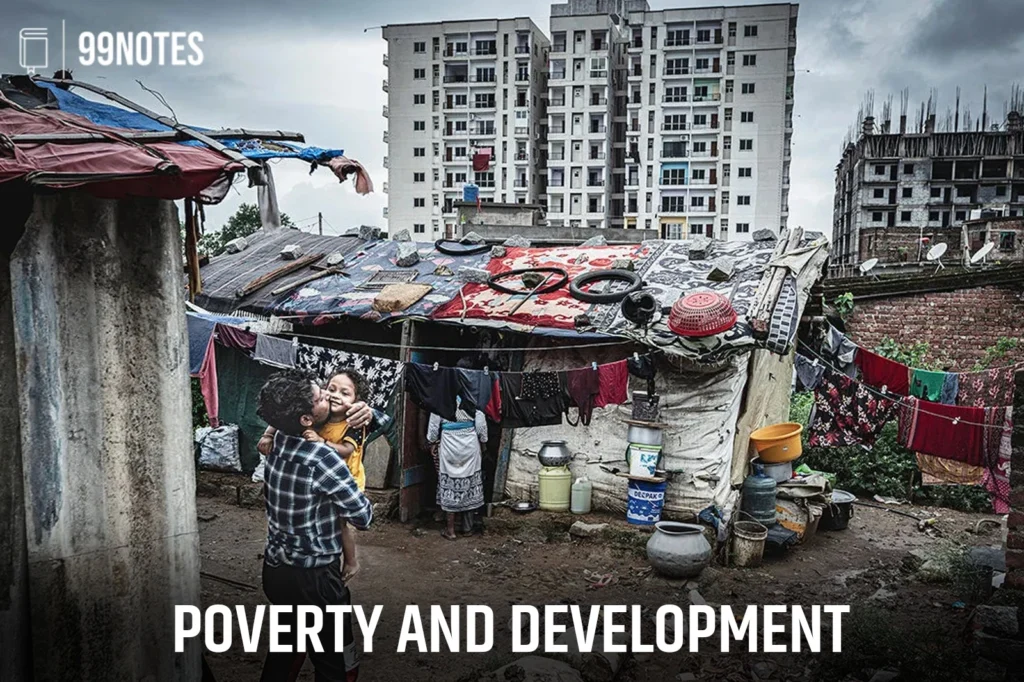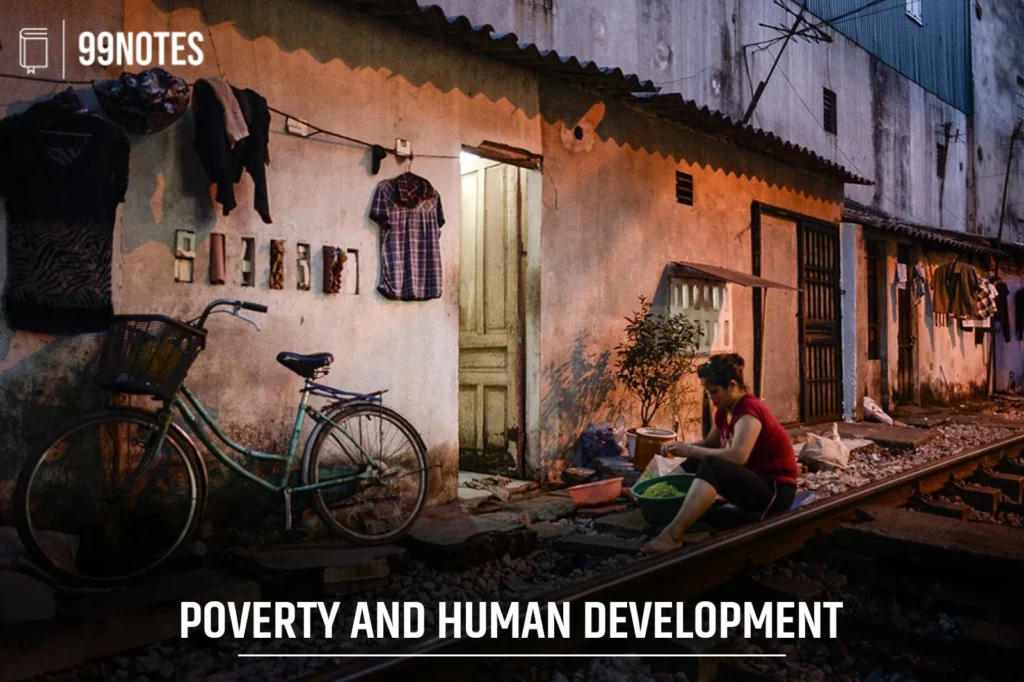
Poverty & Development Issues UPSC Notes Free Download

POVERTY AND DEVELOPMENTAL ISSUES
Poverty is the condition where an individual or group lacks the basic resources and income to meet their essential needs for a minimum standard of living.

Poverty and Human Development
Poverty and human development are deeply interconnected, with poverty often being a major barrier to human development. Human development refers to the process of improving the

POVERTY IN INDIA
Poverty in India has deep historical roots, influenced by colonial policies, post-independence economic strategies, and social inequalities. The history of poverty in India can be categorized into three key periods
Poverty & Development Issues
Poverty and development are important topics for the UPSC Civil Services Exam (CSE). The CSE is a competitive exam that is taken by candidates who aspire to join the Indian Administrative Service (IAS), Indian Foreign Service (IFS), Indian Police Service (IPS), and other central government services.
Poverty refers to the state of being poor, or not having enough resources or income to meet basic needs. Poverty is a complex issue that affects people in many different ways, including lack of access to education, healthcare, and other essential services. It can also lead to social exclusion and discrimination.
Development refers to the process of improving the well-being of individuals, communities, and societies. It involves economic, social, and political changes that enable people to live more fulfilling and productive lives.
There are various approaches to addressing poverty and promoting development, including:
- Economic growth: Promoting economic growth through policies that encourage investment and job creation can help reduce poverty by creating more opportunities for people to earn a livelihood.
- Social protection: Providing social protection measures such as cash transfers, food security programs, and healthcare can help address the immediate needs of poor and vulnerable groups.
- Human capital development: Investing in human capital development through education, training, and healthcare can help individuals and communities build the skills and knowledge needed to participate fully in society and to take advantage of economic opportunities.
- Infrastructure development: Building infrastructure such as roads, schools, and hospitals can help improve access to essential services and facilitate economic growth.
- Governance and institutions: Strengthening governance and institutions can help ensure that development policies and programs are implemented effectively and that they benefit the most vulnerable and marginalized groups.
It is important to understand the various factors that contribute to poverty and to develop a holistic approach to addressing it. This may include addressing issues of inequality, discrimination, and exclusion, as well as promoting economic growth and social development.
Based on its social, economic, and political characteristics, Poverty can be categorised as follows:
1. Absolute destitution
Extreme or abject poverty is characterised by a lack of food, clean water, health care, housing, education, and information.
Those living in abject poverty struggle to survive and incur a high number of child fatalities due to avoidable illnesses.
Absolute poverty is often rare in wealthy nations.
The “dollar a day” poverty level, which was initially adopted in 1990, defined absolute poverty by the criteria of the world’s poorest nations; in 2015, the World Bank updated it to $1.90 a day.
This value is debatable; consequently, each country has its own absolute poverty threshold.
2. Comparative Poverty
It is characterised from a sociological standpoint, as living standard relative to the economic standards of the surrounding population. Consequently, it is a measure of income disparity.
Typically, relative poverty is assessed as the proportion of the population whose income is below a set percentage of the median income.
It is a common method for determining poverty rates in affluent, industrialised nations.
3. Situational Destitution
It is a sort of temporary poverty caused by an unpleasant event such as an environmental disaster, job loss, or serious health crisis.
As poverty results from a series of misfortunes, people may help themselves with even minimal aid.
4. Persistent Poverty
It is passed down via families and individuals from one generation to the next.
This is more difficult since there is no escape because the individuals are ensnared in its cause and cannot obtain the necessary tools to leave.
5. Regional Poverty
This occurs in remote places when there are less employment prospects, services, disability assistance, and decent educational chances.
People here rely mostly on agriculture and other accessible manual labour to support themselves.
6. City Poverty
Due to Poverty, the urban population faces the following significant obstacles:
- limited health and educational resources
- Substandard housing and services
- Due to overpopulation, the environment is violent and unhealthy, and there are little or no social protective mechanisms.
Poverty and Development
Poverty and development are interdependent on one another. The notion of growth is really one of the most important parts of the country’s development.
In contrast to the quantitative character of growth, development is qualitative in nature. A country’s growth is not always indicative of its development. When a nation’s growth is negative, there is insufficient progress. This causes inequality in the nation.
When disparity increases in a nation, it is claimed that the nation is in a condition of poverty, and with poverty comes poor development. Thus, it is evident that the cycle is recurring. This is also known as the poverty cycle.
The regions of Rajasthan, Karnataka, Jharkhand, and Odisha, among others, are notoriously prone to drought. In India, these places are also noted for their extreme poverty. This is mostly due to the absence of strong administration and basic services in these regions. These regions lack a fundamental infrastructure for efficient mobility.
While Eastern India is rich in natural and energy resources, its development rate is limited and it contains some of the poorest states, such as Chhattisgarh and Jharkhand.
Goals for Sustainable Development and Poverty
The first of the 17 Sustainable Development Goals (SDGs) of the 2030 Agenda for Sustainable Development is to eradicate all kinds of poverty.
“Ensure significant mobilisation of resources from diverse sources, including through enhanced development cooperation, to provide adequate and predictable means for developing countries, particularly least developed countries, to implement programmes and policies to end poverty in all its dimensions.”
The SDGs also aim to establish sound policy frameworks at the national and regional levels, based on pro-poor and gender-sensitive development strategies, so that by 2030, all men and women have equal rights to economic resources, as well as access to basic services, ownership and control over land and other forms of property, inheritance, natural resources, appropriate new technology, and financial services, including microfinance.
Types of Poverty:
Poverty can be classified into the following types depending on the various viewpoints:
- Absolute Poverty: It is a situation when an individual is not able to afford essential goods and services such as food, housing and clothes. It is also linked to destitution.
- Relative Poverty: When a person is in a financially or socially disadvantaged position as compared to other people, it is known as Relative Poverty. It is a condition in which people lack bare minimum amount of income needed to maintain the average standard of living.
- Objective Poverty: the studies that use the Information collected by a researcher in terms of the measurement of various variables such as household income, household expenditure, etc, are called objective poverty studies.
- Subjective Poverty: it is an individual’s perception of their financial and material situation. Information collected on the opinions of these individuals or households is used to understand Poverty.
- Multi-dimensional Poverty: it comprises the different deprivations experienced by people with extremely low income in their daily lives, such as deteiorated health, inadequate living standards, lack of education, etc.
Poverty Line Estimation:
A poverty line is a critical threshold of Income, consumption, or access to goods and services. An individual falling below this line is known as poor.
Several expert groups and committees were constituted from time to time to estimate the number of people living in Poverty in India. Some of them are as follows:
- Pre-Independence Poverty Estimates
History of poverty estimation in India:
- One of the earliest references to poverty estimation can be found in the book ‘Poverty and the Un-British Rule in India’ written by Dadabhai Naoroji.
- He formulated the poverty line, ranging from sixteen to thirty-five rupees per capita per year based on 1867–68 prices.
- the poverty line was based on the cost of a subsistence diet consisting of flour or rice, dal, mutton, vegetables, ghee, vegetable oil and salt.
National Planning Committee (NPC) (1938):
- The Poverty line estimated by them was between 15 to Rs. 20 per Capita Per Month.
- The formulated poverty line was based on a minimum standard of living, including nutritional Requirements.
- Post-Independence Estimates:
Working Group:
- The poverty line was quantified for the first time in 1962.
- The Estimated poverty lines included minimum basic requirements comprising food and non-food items for an individual in order to lead a healthy life.
- The rural Poverty and urban poverty lines formulated by this working group were 20 and 25 per capita per month, respectively (excluding health and education).
Study by VM Dandekar and N.Rath (1971):
- The first systematic assessment of poverty in India was made based on National Sample Survey data from 1960-61 by VM Dandekar and N.Rath.
- They formulated the first consumption levels required to meet a minimum average calorie norm of 2,250 calories per capita per day in both rural and urban areas.
- The estimated Poverty line for Rural was Rs. 15 per CapitaCapita per month, and for Urban, it was Rs. 22.5 per CapitaCapita per month
Alagh Committee (1979):
- For poverty estimation, a task force on “Projections of Minimum Needs and Effective Consumption Demand” was constituted by the Planning Commission headed by YK Alagh in 1977, and it submitted its report in 1979.
- They defined poverty line as the per capita consumption expenditure level to meet the average per capita daily calorie requirement of 2400 Kilo calorie per capita capita per day in rural areas and 2100 Kilo calorie per capita per day in urban areas.
- The Rural and Urban Poverty lines were estimated at Rs. 49.09 and Rs. 56.64 per CapitaCapita per month, respectively, based on 1973-74 prices.
Lakdawala Committee (1993):
- An expert Group constituted to review the methodology for poverty estimation made the following recommendations:
- Consumption expenditure should be calculated based consumption of calorie as earlier;
- State-specific poverty lines should be formulated, and these should be updated using the Consumer Price Index-Industrial Worker in urban areas, the Consumer Price Index of Agricultural Labour in rural areas.
- Discontinuation of ‘Scaling’ of poverty estimates based on National Accounts Statistics (NAS). This presumes that the basket of goods and services used to calculate Consumer Price Index-Industrial Worker and Consumer Price Index-Agricultural Labour reflects the consumption patterns of people with low incomes.
Tendulkar Committee (2009):
- In 2005, another expert group headed by Suresh Tendulkar was constituted by the Planning Commission to review the methodology used for poverty estimation,
- There were certain shortcomings in the previous method, based on which the committee introduced four changes. These are as follows:
- The committee recommended a shift from calorie consumption-based norms to target nutritional outcomes for poverty estimation and poverty lines.
- A similar poverty line basket across rural and urban India
- A change in the price adjustment procedure to correct issues related to region and time with price adjustment
- Inclusion of private expenditure on education and health while estimating Poverty.
- The Estimated National Poverty line for 2011-12 was eight hundred and sixteen rupees per capita per month for rural areas and thousand rupees per Capita per month for urban areas.
Rangarajan Committee (2014):
A new expert panel was set up on poverty estimation, headed by C Rangarajan.
The objective of the committee was:
- To provide an different alternate method to estimate poverty levels and scrutinise whether poverty lines should be fixed only in terms of a consumption basket or if other criteria are also relevant
- To examine the divergence between the consumption estimates based on the NSSO methodology and those emerging from the National accounts aggregates.
- To assess international poverty estimation methods and indicate whether, based on these, a specific method for empirical poverty estimation can be developed in India.
- To suggest how these Poverty estimates can be linked to eligibility and entitlements under the Government’s various schemes.
- Monthly per capita expenditure of 972 in rural areas and Rs. 1407 in Urban Areas is recommended as the poverty line at the India Level.
Task Force by NITI Aayog (2015):
The Task Force studied the issue of whether a poverty line is required and suggested four options for tracking the poor:
- Continue with the poverty line given by the Tendulkar committee
- Switch to the Rangarajan or higher rural and urban poverty lines
- Check on the progress of the bottom 30% of the population
- Track progress along specific particular components of material Poverty such as nutrition, housing, electricity, drinking water, sanitation, and connectivity.
Poverty Alleviation Programmes in India:
There are many poverty alleviation programmes in India targeting mainly rural Poverty as the prevalence of Poverty is higher in rural India. It comprises many wage employment programmes, self-employment programmes, social and food security programmes, skill India, etc. Some of them are as follows:
- Jawahar Gram Samriddhi Yojna
- National Old age Pension scheme
- National Family Benefit Scheme
- Annapurna Scheme
- Pradhan Mantri Gramin Awaas Yojna
- Mahatma Gandhi National Rural Employment Guarantee Act (MGNAREGA)
- Integrated Rural Development Programme.

